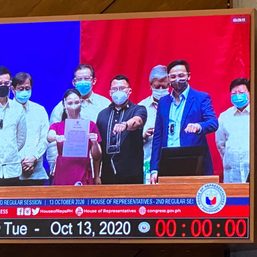SUMMARY
This is AI generated summarization, which may have errors. For context, always refer to the full article.
MANILA, PHILIPPINES — “It makes us happy to have a lot of children in the house,” Rosalie Cabinyan says in Filipino. “There is endless laughter and cheer with all of them moving about.”
“I guess the only time it gets difficult is during eating time. There’s never enough to eat.” Her cheerful tone changes; her eyes turn misty. “My grade 4 daughter cries when she’s hungry. Often, I have no food to give her so I just end up crying, too.”
Cabinyan, a 55-year-old housewife, lives in Baseco, Tondo, Manila, one of the poorest communities in the city, with her husband and their 17 children. Her husband works as a janitor.
Cabinyan has been pregnant 22 times, but 5 of her children died.
“I first got pregnant when I was 16 years old. We lived in a very remote part of Baseco then. There were health workers who would visit us and talk to us about family planning and birth spacing. I was open to it, but we lived so far that they could only visit once every three months,” Cabinyan recalls.
In between those visits, Cabinyan would get pregnant again. “I guess I’m just one of those women who gets pregnant easily,” she adds.
Cabinyan says that she and her husband had wanted to have only 3 children, but she was hesitant to try birth control.
“I’ve never tried pills or IUD because my friends told me that would be bad for my goiter,” she relates. And condoms, she says, looking shyly downward, were out of the question for her husband.
“The doctor already told me it is dangerous for me to keep on having more children, I think after my 4th or 5th child, but what can I do?” Cabinyan asks.
City ordinance
Cabinyan is one of the 5.25 million Filipino women who do not have access to contraception, according to the Guttmacher Institute, a US-based reproductive health think tank that specializes in reproductive health care research.
In a May 2010 study entitled, “Facts on Barriers to Contraceptive Use in the Philippines,” Guttmacher found that women between the ages of 15-49 only want 2.4 children but end up having an average of 3.3.
Apart from the cost and lack of awareness, the study also showed that the most common reasons why women do not practice contraception are health concerns about contraceptive methods, including fear over their possible side effects. At least 44% reported these reasons in 2008, as did 41% in 2003.
In 2008, according to the United Nations Population Fund, an estimated 3.4 million Filipino women became pregnant, with 54% of them (around 1.9 million) having unintended pregnancies.
What makes it more difficult for women like Cabinyan is the fact that they live in Manila where a local city ordinance, Executive Order 003, is in place.
Under EO 003, enacted by then Mayor Lito Atienza in 2000, the City of Manila declares its “total commitment and support to the responsible parenthood movement.”
In this ordinance, responsible parenthood means promoting only natural forms of contraception for family planning.
In effect, none of the government hospitals and clinics in the city of Manila offer modern forms of contraception like condoms, pills and services like vasectomy and tubal ligation.
“Since the issuance of EO 003, there has been no procurement of products and services in city health centers and hospitals which are not in the category of natural family planning method,” says Dr. Junice Melgar, executive director of Likhaan Women’s Health. Likhaan runs community health clinics in various parts of Manila.
‘Imposing Misery’
The women of Manila suffered during the implementation of the contraception ban.
In the report entitled, Imposing Misery, a collective study done by various women’s groups, including Likhaan, women had to resort to sleeping in separate homes from their husbands just to avoid having intercourse with them. Some husbands insinuated that their wives were having affairs and were beaten for refusing to have sex.
Others were advised by their health care provider to avoid additional pregnancies, but could not offer services like ligation. The women would be advised to transfer to another hospital, where they could have the procedure, but would have to pay for it.
Women’s groups and NGOs also suffered as a result.
“EO 003 meant that modern forms of contraception would not be funded by the city government. So NGOs and civil society groups had to fill in the gap when it came to reproductive health services. But even that was difficult. Many of our staff were harassed for conducting sexuality seminars or giving out condoms,” adds Melgar.
Going to court
In January 2008, a group of Manila residents, with the help of the Commission of Human Rights (CHR) and ReproCen, a reproductive rights and health organization based in the University of the Philippines in Manila, filed a class action suit against the City of Manila and the implementation of EO 003.
The case, Lourdes Osil et al. v. Mayor of Manila, with Beth Pangalangan as lead counsel, labeled the provisions of EO 003 as a violation of various treaties that the Philippines is a signatory of. These include the UN Convention on the Elimination of All Forms of Discrimination Against Women (CEDAW); various provisions found in the 1987 Constitution,; and the Magna Carta for Women of 2009.
“The City Council of Manila should immediately revoke EO 003, and ensure that artificial birth control devices, including birth control pills and injectables be made available to all adult citizens who are residents within its jurisdiction, in health centers and hospitals,” said a report signed by CHR Chairperson Loretta Ann Rosales.
Filed with the Court of Appeals, the case was dismissed in May 2011.
An appeal was filed before the Supreme Court in September 2008 but was also dismissed.
New hope
The groups however continued to hold dialogues with the Manila Health Office under Mayor Alfredo Lim (who defeated Atienza in 2007).
In November 2011, City Hall issued a new ordinance, EO 30, entitled “Further Strengthening Family Health Services.”
It clearly gives couples birth control choices, following the principle of responsible parenthood.
But what would this mean for the women of Manila? And for women like Rosalie Cabinyan who had had too many? – Rappler.com
(Next: The limitations of the law)
Add a comment
How does this make you feel?




There are no comments yet. Add your comment to start the conversation.